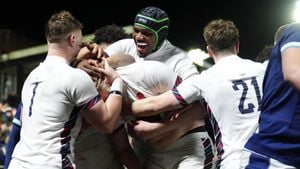Luigi Mangione, the 26-year-old former Ivy League student accused of assassinating UnitedHealthcare CEO Brian Thompson, returned to court last Friday as his high-profile trial continues to capture national attention. Facing multiple murder and terrorism charges stemming from the December 4, 2024, shooting, Mangione's case is shrouded with compelling narratives, including his supporters viewing him as a modern-day Robin Hood.
During the brief hearing, which lasted approximately 10 minutes, Mangione arrived punctually at 2:24 p.m. wearing a bulletproof vest under his green sweater. Assistant District Attorney Zachary Kaplan indicated to the court the prosecution would be providing 800 GB of discovery, which includes surveillance video and forensic evidence related to the case. Defense attorney Karen Friedman Agnifilo raised objections concerning deadlines for evidence disclosure, highlighting the complexity as Mangione faces three separate criminal cases, along with allegations of police misconduct.
Outside the courthouse, Agnifilo expressed her concern about the media's portrayal of the case, particularly highlighting events featured in an HBO documentary involving the New York City Mayor Eric Adams and interactions with the police. "I didn’t understand how this week on HBO I see NYPD... talking about evidence we had not received," she lamented. Meanwhile, supporters gathered to chant, sporting green attire reminiscent of the Nintendo character Luigi, expressing their demand for Mangione's release.
Mangione stands accused of tracking Thompson for weeks prior to the murder, which authorities contend was premeditated. Prosecutors constructed the narrative of Mangione as having coldly executed his alleged crime outside the Hilton hotel where Thompson was set to attend an investor conference. The stakes are high as the court gears up for jury selection, with significant fears around the potential for jury nullification—where jurors deliver verdicts based on ideology rather than the law.
Defense attorney Elcox emphasized the importance of jury selection, noting, "Jury selection is going to becritical in Mangione’s case." Elcox explained how public perception of Mangione has evolved, primarily fueled by the extreme dissatisfaction many hold against conglomerates within the healthcare sector. Notably, the deceased, Thompson, was recognized as a controversial figure tied to grievances about the insurance industries, potentially influencing juror perspectives.
Interestingly, financial backing for Mangione’s defense has surged over recent weeks, amassing over $500,000 nationwide amid more than 10,000 individual donations. Critics and supporters alike observe the strangeness of the juxtaposed narratives: the sympathy for the accused versus the increasingly unpopular victim wrapped within corporate disdain.
Paul Mauro, former NYPD inspector, weighed in on the jury dynamics, stating, "Yes, this is the venue... but I don’t think even Manhattan criminal justice has been completely defanged." Mauro suggested the evidence against Mangione was compelling and will be taken seriously by jurors, even with the backdrop of potential public support swinging toward the defendant.
Central to the overwhelming support for Mangione are concerns voiced by citizens dissatisfied with healthcare practices. Some individuals paint him as not just the perpetrator of the crime but rather as someone challenging the healthcare status quo. This complex narrative adds fire to the discussions surrounding the legal proceedings against him.
Mangione’s defense team launched its website to engage with the public and update supporters on case developments. While the legal battle continues, Mangione released his first statement since his arrest, expressing gratitude for all the letters and support he has received, emphasizing his awareness of the multitude of perspectives reached across political and social lines.
His remarks reflected light on the unique place he occupies—caught between societal grievances and the legal ramifications of his actions. Meanwhile, the anticipated upcoming trial continues to be surrounded by uncertainty as its developments push both sides toward defining outcomes fraught with public interest, media scrutiny, and the immediate challenge of jury selection.
Given the case’s significant ramifications, both legally and socially, observers and parties involved are closely following outcomes as they present challenges not just for Mangione, but also for the intersection of individual actions against corporate entities within the convoluted healthcare debate.



